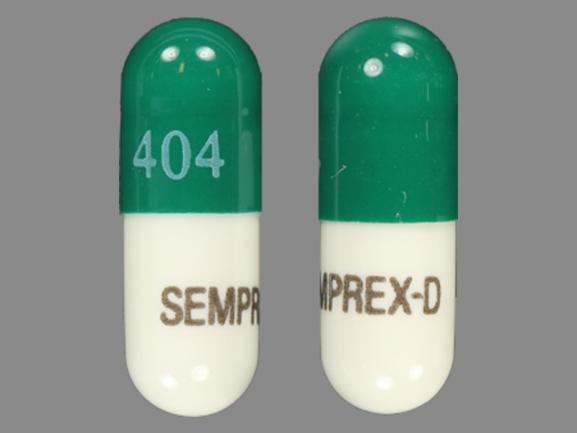Semprex-D and Alcohol/Food Interactions
There are 2 alcohol/food/lifestyle interactions with Semprex-D (acrivastine / pseudoephedrine).
Pseudoephedrine Caffeine
Moderate Drug Interaction
MONITOR: Coadministration of two or more sympathomimetic agents may increase the risk of adverse effects such as nervousness, irritability, and increased heart rate. Central nervous system (CNS) stimulants, particularly amphetamines, can potentiate the adrenergic response to vasopressors and other sympathomimetic agents. Additive increases in blood pressure and heart rate may occur due to enhanced peripheral sympathetic activity.
MANAGEMENT: Caution is advised if two or more sympathomimetic agents are coadministered. Pulse and blood pressure should be closely monitored.
References (7)
- Rosenblatt JE, Lake CR, van Kammen DP, Ziegler MG, Bunney WE Jr (1979) "Interactions of amphetamine, pimozide, and lithium on plasma norepineophrine and dopamine-beta-hydroxylase in schizophrenic patients." Psychiatry Res, 1, p. 45-52
- Cavanaugh JH, Griffith JD, Oates JA (1970) "Effect of amphetamine on the pressor response to tyramine: formation of p-hydroxynorephedrine from amphetamine in man." Clin Pharmacol Ther, 11, p. 656
- (2001) "Product Information. Adderall (amphetamine-dextroamphetamine)." Shire Richwood Pharmaceutical Company Inc
- (2001) "Product Information. Tenuate (diethylpropion)." Aventis Pharmaceuticals
- (2001) "Product Information. Sanorex (mazindol)." Novartis Pharmaceuticals
- (2001) "Product Information. Focalin (dexmethylphenidate)." Mikart Inc
- (2002) "Product Information. Strattera (atomoxetine)." Lilly, Eli and Company
Alcohol (Ethanol) Acrivastine
Moderate Drug Interaction
GENERALLY AVOID: Alcohol may potentiate some of the pharmacologic effects of central nervous system (CNS)-active agents. Use in combination may result in additive CNS depression and/or impairment of judgment, thinking, and psychomotor skills.
MANAGEMENT: Patients receiving CNS-active agents should be advised to avoid or limit consumption of alcohol. Ambulatory patients should be counseled against driving, operating machinery, or engaging in potentially hazardous activities requiring mental alertness and motor coordination until they know how these agents affect them, and to notify their physician if they experience excessive or prolonged CNS effects that interfere with their normal activities.
References (5)
- Warrington SJ, Ankier SI, Turner P (1986) "Evaluation of possible interactions between ethanol and trazodone or amitriptyline." Neuropsychobiology, 15, p. 31-7
- Gilman AG, eds., Nies AS, Rall TW, Taylor P (1990) "Goodman and Gilman's the Pharmacological Basis of Therapeutics." New York, NY: Pergamon Press Inc.
- Cerner Multum, Inc. "UK Summary of Product Characteristics."
- (2012) "Product Information. Fycompa (perampanel)." Eisai Inc
- (2015) "Product Information. Rexulti (brexpiprazole)." Otsuka American Pharmaceuticals Inc
Switch to consumer interaction data
Semprex-D drug interactions
There are 489 drug interactions with Semprex-D (acrivastine / pseudoephedrine).
Semprex-D disease interactions
There are 10 disease interactions with Semprex-D (acrivastine / pseudoephedrine) which include:
- cardiovascular disease
- renal dysfunction
- anticholinergic effects
- asthma/COPD
- cardiovascular
- GI narrowing
- PKU
- BPH
- diabetes
- glaucoma
More about Semprex-D (acrivastine / pseudoephedrine)
- Semprex-D consumer information
- Check interactions
- Compare alternatives
- Reviews (11)
- Drug images
- Side effects
- Dosage information
- During pregnancy
- Drug class: upper respiratory combinations
Related treatment guides
Drug Interaction Classification
| Highly clinically significant. Avoid combinations; the risk of the interaction outweighs the benefit. | |
| Moderately clinically significant. Usually avoid combinations; use it only under special circumstances. | |
| Minimally clinically significant. Minimize risk; assess risk and consider an alternative drug, take steps to circumvent the interaction risk and/or institute a monitoring plan. | |
| No interaction information available. |
See also:
Further information
Always consult your healthcare provider to ensure the information displayed on this page applies to your personal circumstances.


